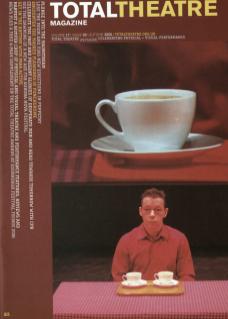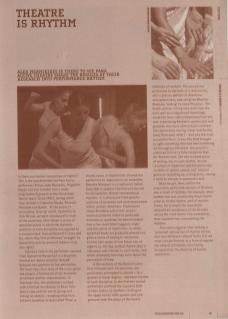Is there a universal natural law of rhythm? This is the question that led Para Active performers Persis-Jade Maravala, Magdelen Hayes and Zoe Crowder into a week-long research project at the Chisenhale Dance Space (June 2005), during which they trained in Capoeira Abuda, Bharata Nhatyam and Butoh. At the project's concluding 'sharing' event, hosted by Dr Dick McCaw, we were introduced to each of the practices, then shown a series of demonstrations in which the rhythmic qualities of each discipline was applied to a common text: Samuel Beckett's Come and Go, which they first performed 'straight' (a beautifully precise piece of theatre in its own right).
Capoeira (which the performers learned from Capoeirist Manjerico) is a Brazilian martial art-dance practice 'played between two partners to live percussion’. The basic four-four time of the music gives the players a framework of set moments of contact for improvisation. To illustrate this, the performers worked with a limited vocabulary (a basic folk dance step and the act of giving and taking an object), revealing what Para Active's Jonathan Grieve called 'flow', a shared sense of rhythm that allowed the performers to improvise as an ensemble. Bharata Nhatyam is a traditional Indian form that is spoken/chanted and danced to very precise, almost mathematical rhythms. It is structured from specific patterns of accented and unstressed beats within sixteen-beat bars. Practitioner Shane Shambhu noted that certain metrical patterns relate to particular emotions or qualities: he demonstrated how a five-beat block suggests anger and how series of repetitions, in which accented beats are gradually phased out, gives a sense of ending or resolution. Yumino Seki spoke of how Butoh has an organic Jo-Ha-Kuy cyclical rhythm that is individual and internal to each artist, and which ultimately becomes more about the perception of time
In the versions of the Beckett piece that followed each introduction, the performers attempted to absorb – to a greater or lesser degree – the basic rhythm of each discipline. In the first the seated performers confined the Capoeira beat to their bodies (a rhythmic shifting of the upper torso) while spoken text and gestures took the place of the form's moments of contact. The second was performed to the beat of a metronome, with a precise pattern of directions and spoken text, and using the Bharata Nhatyam 'ending' to close the piece. The Butoh version, a long slow walk from the back wall to a ring placed downstage, made the most radical departure from the text, translating Beckett's spoken text and gestures into more abstracted movement (the performers moving closer and further away from each other) – and was the most successful for it. It was this that brought to light something that had been bothering me throughout the event: the project's admitted failure to fully recognise that the Beckett text, like any scripted piece of writing, has its own rhythm: its own structure of repetition and the particular rhythms of spoken speech and 'natural’ gestures (standing up, sitting down, raising a hand to whisper in someone's ear).
What we got, then, within the exquisitely performed versions of Beckett, was a clash of rhythms, for example, when spoken text was unnaturally disjointed in order to fit the rhythm; and of stylistic forms, for example the essentially naturalistic vocabulary of the Beckett versus the more dance-like movements that resulted from internalising the rhythms.
This clash suggests that seeking a universal natural law of ‘rhythm' across four very different cultural forms (for we must include Beckett as a form alongside the others) ultimately risks failing to appreciate the diversity of human expression.

